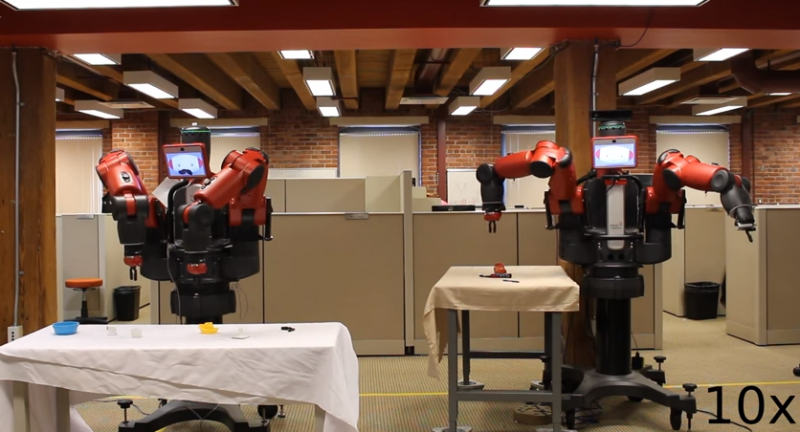November 17, 2015 weblog
Power in numbers applies to robots learning grasping skills

National Public Radio said it well: How can robots learn new tasks? Practice, practice practice.
Stefanie Tellex, Brown University assistant professor in computer science department, talked to NPR recently about getting robots to do better at real-world tasks—specifically, grasping, why grasping is hard for a robot, and what her team would like to do about it.
Tellex works with a "Baxter," the industrial robot made by Rethink Robotics with its box-like torso and arms.
Joe Palca, NPR science correspondent, watched the Baxter try to pick up a battery; he said watching it was a little like watching paint dry. He told her this looked pathetic. She laughed, knowingly.
Stuff that is really hard for a robot to do is almost effortless for a person to do. A human spends little conscious awareness of exercising perception, planning and control in picking up an object. But the robot from scratch doesn't know from kazoos, batteries and pens.
It gets information from its cameras. And that information, he said, is just a bunch of numbers.
Palca said Tellex thinks the way robots will get better and faster in picking up unfamiliar objects is to give them programs which let them learn from experience just as a child would.
Unsurprisingly, Tellex has had her Baxter working around the clock. It picks up objects. It puts them down. Repeat. Repeat. And so on. But Tellex also has an idea for speeding up the learning curve.
She hopes to recruit some more Baxter robots elsewhere which are left idle off-hours during robotics research projects to do the same tasks as her Baxter to speed up the process. Pace said it evokes the saying, many hands do light work.
Simply put, said Will Knight of MIT Technology Review, "hundreds of robots could accelerate the process by sharing knowledge."
Just how fast would this learning curve speed up learning?
According to Knight, Tellex counted around 300 Baxter robots in research labs around the world and if each of those robots were to use both arms to examine new objects, it would be possible for them to learn to grasp a million objects in 11 days.
The concept of a robot teaching itself how to do tasks is of interest among researchers beyond Brown. Last month, MIT Technology Review looked at the work of Lerrel Pinto and Abhinav Gupta at Carnegie Mellon University. They worked with a Baxter, giving it deep learning capabilities, placing it in front of a table with different sized objects and left it to learn how to grasp them.
The robot was left for up to 10 hours a day. If the robot dropped an object on the floor, there were others it could continue with.
Lab work dedicated to robots gaining better grasping skills may result in robots that will be part of daily life.
Tellex said, "In twenty years, every home will have a personal robot which can perform tasks such as clearing the dinner table, doing laundry, and preparing dinner. As these machines become more powerful and more autonomous, it is critical to develop methods for enabling people to tell them what to do."
© 2015 Tech Xplore




















